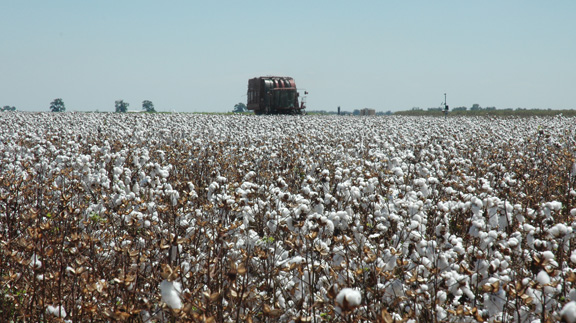Farm & Ranch
Farm bill decision-aid workshop set for Jan. 21 in SanAngelo

By: Steve Byrns
Writer: Steve Byrns, 325-653-4576, [email protected]
Contact: Bill Thompson, 325-653-4576, [email protected]
SAN ANGELO – The Texas A&M AgriLife Extension Service will conduct a farm bill decision aid-workshop from 8 a.m.-5 p.m. Jan. 21 at the Region 15 Education Center, 612 S. Irene St. in San Angelo.
“This workshop is specifically tailored to producers who don’t have Internet access, are uncomfortable with the data entry process or with interpreting the generated results from that data entry,” said Bill Thompson, AgriLife Extension economist at San Angelo and the workshop’s main speaker.
The new farm bill eliminated many of the commodity programs producers were familiar with and had used for years, Thompson said. This new program gives producers the ability to choose between three distinctly different commodity programs in addition to possibly reallocating crop base acres and updating program yields.
“The details of these programs can be complex to comprehend and very difficult to work through to determine which program best addresses the risk-management need of each farm,” Thompson said. “This is why the Agriculture and Food Policy Center in the Department of Agricultural Economics at Texas A&M University has developed an online producer decision aid, specifically for helping producers with these options. The decision aid is available at https://usda.afpc.tamu.edu/ .
“The decision aid also requires a lot of historical data, which is readily available from their crop insurance agent and the FSA office. The data entry process is relatively simple and the results are available almost instantly, allowing producers to run multiple scenarios quickly to determine which option best fits their respective operation.”
Thompson said through this hands-on workshop, producers will enter actual production data and begin to evaluate their choices from among the Price Loss Coverage, or PLC, program and two distinctly different Agricultural Risk Coverage, or ARC, programs. With this information, Thompson said producers will be able to sign up their farms at their respective Farm Service Agency office.
The workshop is free, but participants are asked to RSVP by Jan. 20 by calling the AgriLife Extension office in Tom Green County at 325-659-6524. More information is also available by calling the county office or by contacting Thompson at 325-653-4576, [email protected] .
-30-
Farm & Ranch
Managing Show Cattle Through The Winter

By Heather Welper
Husband and wife duo, Heather and Calvin Welper, are the Co-Owners and Operators or Two C Livestock, located in Valley View, Texas.
The pair’s operation has a show cattle focus where they raise and sell purebred heifers of all breeds and club calf Hereford steers.
When it comes to show cattle, the Welpers know a thing or two including how to prepare for the cold winter months and the Texas major show season run.
To read more, pick up a copy of the November edition of North Texas Farm & Ranch magazine, available digitally and in print. To subscribe by mail, call 940-872-5922.

Farm & Ranch
Double M Ranch & Rescue

By Hannah Claxton, Editor
As the sun rises each day, so do the dozens of mouths that Meghan McGovern is responsible for getting fed. Rather than the sounds of a rooster crowing, McGovern hears the bellows and bleats of a variety of exotic deer, the chortle of kangaroos, the grunts of water buffaloes, and the chirps of a lemur.
Nestled against the banks of the Red River, the Double M Ranch and Rescue, with its high game fences and deer sprinkling the landscape,s its in stark contrast to the surrounding ranches.
“Having deer is kind of like eating potato chips- you can never actually have just one,” said McGovern with a laugh.
McGovern has several herds to take care of- fallow deer, axis deer, water buffalo, goats, and bison. In smaller numbers, there’s also a few kangaroos, a lemur, a potbelly pig, a pair of zebras, a watusi, and a few horses.
To read more, pick up a copy of the November edition of North Texas Farm & Ranch magazine, available digitally and in print. To subscribe by mail, call 940-872-5922.

Farm & Ranch
Acorn Toxicity

By Barry Whitworth, DVM, MPH
With the prolonged drought, most pastures in Oklahoma end up in poor condition. With the lack of available forage, animals may go in search of alternative foods.
If oak trees are in the pastures, acorns may be a favorite meal for some livestock in the fall. This may result in oak poisoning.
Oak leaves, twigs, buds, and acorns may be toxic to some animals when consumed.
To read more, pick up a copy of the November edition of North Texas Farm & Ranch magazine, available digitally and in print. To subscribe by mail, call 940-872-5922.

-

 Country Lifestyles2 years ago
Country Lifestyles2 years agoScott & Stacey Schumacher: A Growth Mindset
-

 Country Lifestyles8 years ago
Country Lifestyles8 years agoStyle Your Profile – What your style cowboy hat says about you and new trends in 2017
-

 HOME8 years ago
HOME8 years agoGrazing North Texas – Wilman Lovegrass
-

 Outdoor10 years ago
Outdoor10 years agoButtercup or Primrose?
-

 Country Lifestyles5 years ago
Country Lifestyles5 years agoAmber Crawford, Breakaway Roper
-

 Equine1 year ago
Equine1 year agoThe Will to Win
-

 Country Lifestyles9 years ago
Country Lifestyles9 years agoJune 2016 Profile – The man behind the mic: Bob Tallman
-

 Country Lifestyles8 years ago
Country Lifestyles8 years agoDecember 2016 Profile, Rusty Riddle – The Riddle Way




